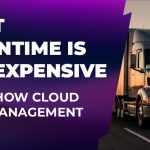
The time to grow your business is now. The question is: How do you do it? With the right kind of technology, things start moving much faster. But how can you invest in technologies that will help you grow your business? That’s where logistics and TMS come in. It’s the backbone that allows any company to grow rapidly. However, few know about it, and even fewer understand its importance in accelerating growth.
We’ll learn today how TMS supports companies in managing and shipping their goods effectively. But let’s first talk about why a transportation management system is necessary.
What is a Transportation Management System?
Modern supply chain and logistics companies now operate on the foundation of a transportation management systems (TMS). You can plan, carry out, and optimize freight transportation with specifically created software called TMS. A TMS carries out three primary tasks:
- Determine shippers and evaluate costs
- Book shipments at the lowest costs
- Shipment tracking
A TMS increases shipping efficiency, lowers costs, and provides real-time visibility into the supply chain. Customer service can be significantly enhanced while your entire shipping process is made more efficient.
Why Does Logistics Need a Transport Management System?
The consumer of today hates waiting. Your company must adapt to your customer’s preferences.
Supply chain and logistics services are in high demand. Between 2019 and 2023, parcel deliveries are anticipated to rise by 17% to 21% annually. The percentage of revenue attributed to logistics expenses will increase by 50% due to same-day delivery.
On top of that, initiatives like Amazon Prime have established standards! How can modern logistics companies ensure their customers receive excellent care at reasonable delivery costs?
Like most shipping companies, you can adopt a transportation management system to overcome the issues. A TMS is perfect for usage by shippers, carriers, and logistics service providers. It is also favored by other companies, including:
- Manufacturing
- Wholesalers
- E-commerce
- Retailers
- Third-party Logistics Providers
TMS is increasingly acknowledged as a worldwide trade and logistics enabler, assisting your company’s growth.
Functions of a Transportation Management System
Four key features of transportation management software include:
-
Logistics/ Freight Management
One principal focus for supply chain and logistics firms is freight or logistics management. Using technology like automation, effective freight management lowers waste and unnecessary costs and accelerates your business.
TMS can compare current rates from various carriers in real-time. You can manage and negotiate tariffs without calling many providers from a single interface. Tens of thousands of carriers can be supported by a TMS without any issues!
A transport management system can help streamline operations, automate tasks, and use less paper. You can benefit from order management, load tendering, and other advanced features.
-
Execution
A TMS makes execution simple. Real-time bookings are possible, as are critical freight management operations. Thanks to a transportation management system software, you can track your goods at any time and have real-time visibility into how they are moving.
Additionally, you can obtain all shipping-related information in one location and communicate the relevant information to customers and clients. This solution also enables remote time and distance tracking and driver communication.
You can use the dashboard to get a thorough picture of your organization’s operations and make wise business decisions.
-
Organizing and Planning
One of the primary objectives of a transportation management software is to optimize the shipping process. Your TMS will offer all the data and analytics required to optimize your shipping procedure and deliver items quickly and affordably.
Additionally, you can maximize resource usage by using your TMS to enhance less-than-truckload (LTL) shipments. Your fleet can save fuel and workforce money by arranging multi-leg trips and removing unnecessary miles between delivery locations.
For in-depth analysis, business intelligence systems can be connected with TMS analytics. You may delve deeply into your logistics business with the insights to find significant trends and patterns.
-
Administration
A TMS has robust reporting and documentation features to ensure compliance and eliminate paper-based processes. You can take advantage of features like:
- Billing and Payment
- Invoice creation
- Generating bills of lading
- Monitoring payments
By verifying freight milestones like collection, delivery, and transit time, sophisticated transport management systems also take care of the driver, truck, and broker settlements. Using the data from your TMS, you may also determine client demand.
Conclusion
In simpler words, TMS or transportation management systems are software programs that keep track of your shipments and other logistics activities. We will discuss more of TMS systems and their benefits in the next blog so stay in touch.
TMS-Digital is an end-to-end transportation management system that helps you streamline your freight business by tracking inventory, monitoring shipping, and improving your order-to-delivery process. TMS-Digital’s robust features and user-friendly interface help you grow your business and reduce costs.
TMS-Digital also offers a variety of other valuable features that can help you grow your business, including inventory management and a mobile app. Get in touch with an expert today and learn how we help your business grow.










